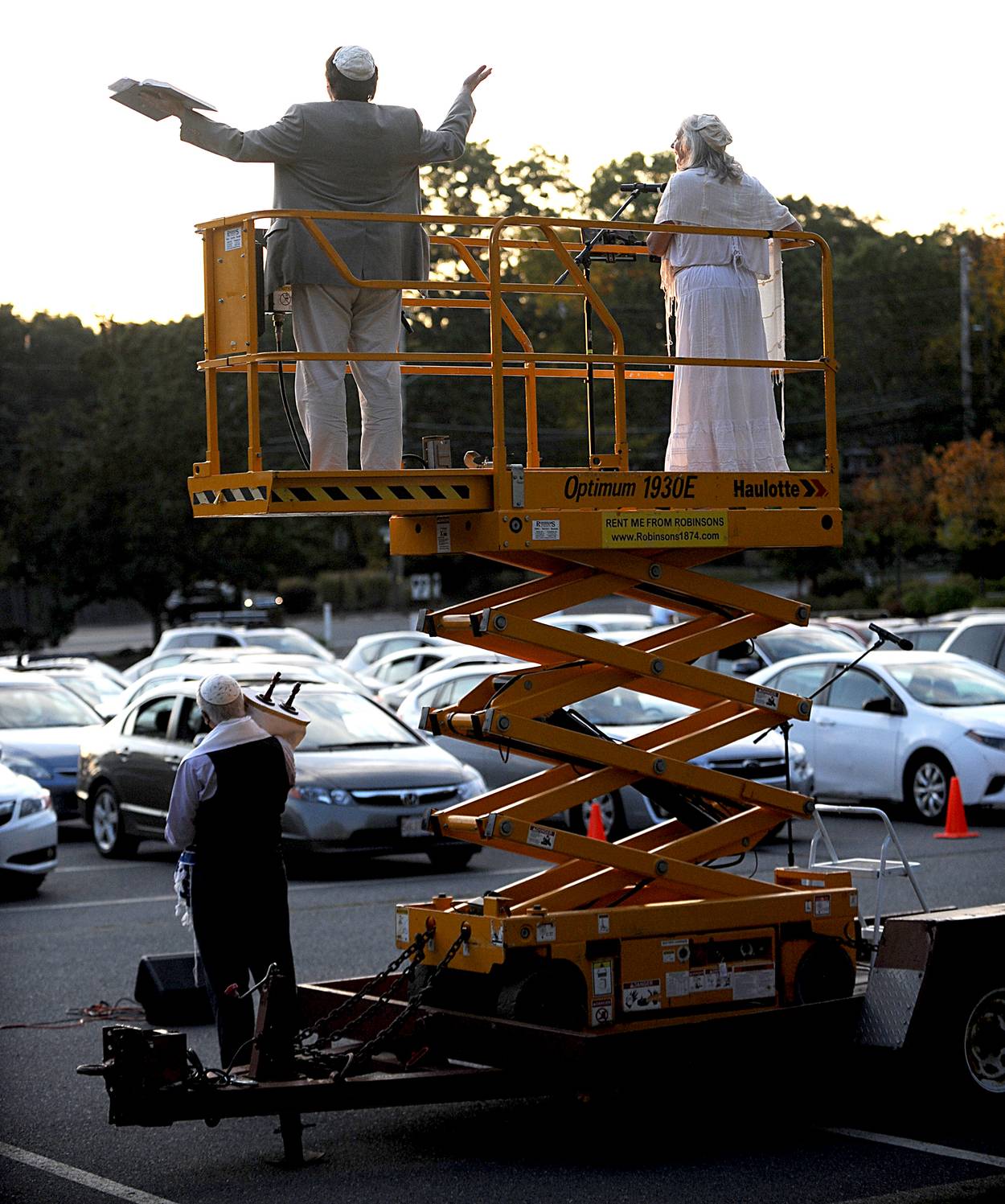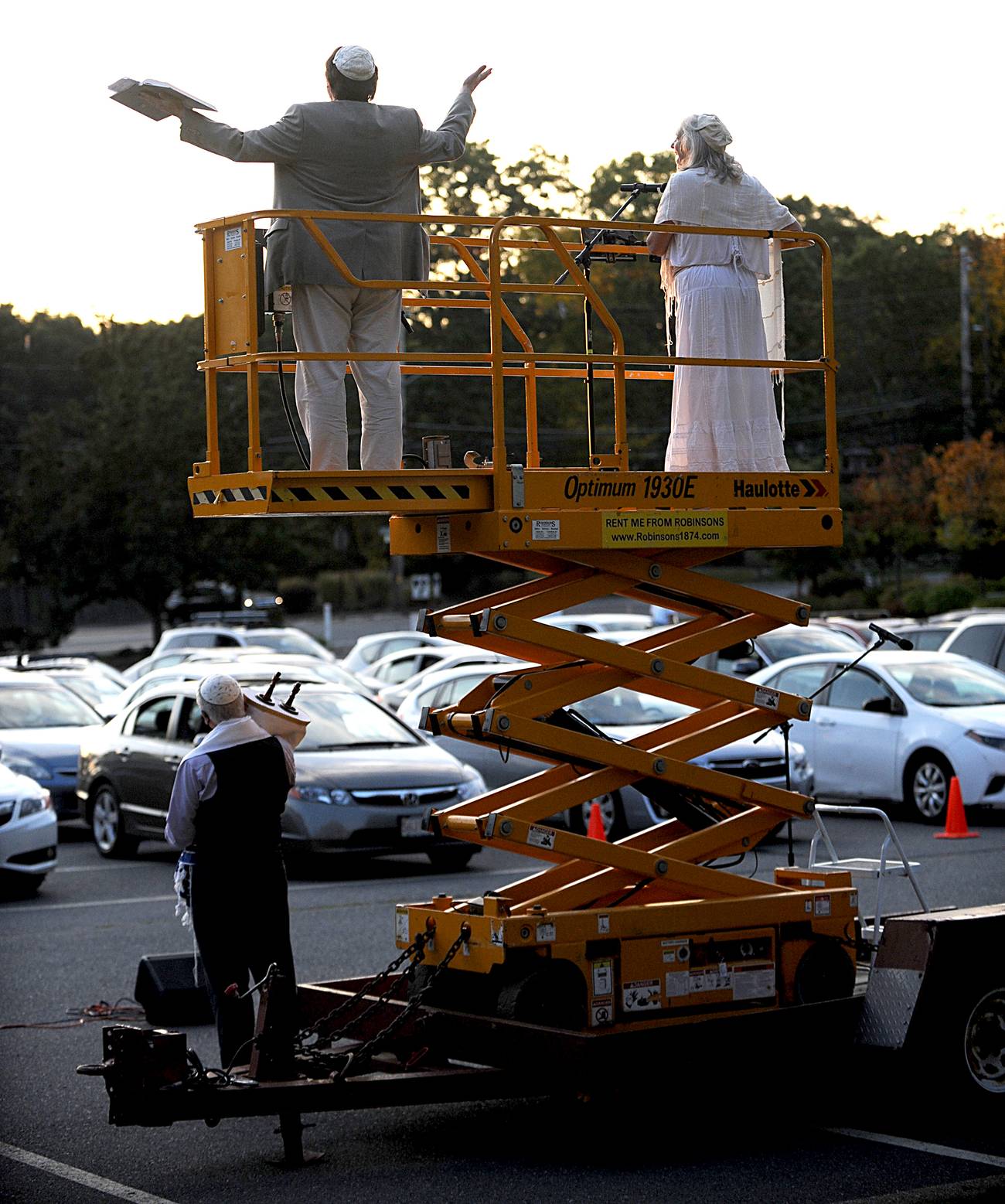The Great Streaming Experiment
Synagogues around the country held virtual High Holiday services for the first time this year. How did it go?




From livestreaming services to empty sanctuaries, this year’s High Holidays were unlike those ever experienced before. Homes became sacred spaces, Torah readers chanted from their living rooms, and the blasts of the shofar were sounded over computer screens or socially distanced gatherings in parks and parking lots, or at drive-by car parades. Synagogue choirs sang traditional melodies on prerecorded videos, while virtual Yizkor books flashed images of deceased relatives.
Rabbis and cantors spent a record number of hours preparing for the High Holiday season, reinventing familiar processes for a virtual platform while quickly ramping up to new technology. A stable network connection was the prayer of the day—as Cantor Matt Axelrod expressed in Hineini for Virtual Services: “Here I stand, pixilated and buffering before You, streaming on behalf of your people Israel, even though my wifi is insufficient for the task.”
Against the backdrop of the pandemic, entering the High Holidays in a virtual space created angst for clergy and congregants alike. “We started with a great sense of uncertainty since no one anywhere had done this before,” said Rabbi Roly Matalon of B’nai Jeshurun, a 1,800-household nonaffiliated congregation in New York City. “There was a lot of uncertainty, trepidation, and loss of not being together as a community.”
Nevertheless, these concerns did not materialize, according to conversations Tablet held recently with synagogues across the U.S.—Reform, Conservative, Reconstructionist, and nonaffiliated; small, medium, and large congregations in suburban and urban areas alike.
Several key trends emerged: High Holiday services far exceeded expectations, creating a strong sense of intimacy and community even though people were not physically together. Attendance at virtual services generally exceeded in-person services before the pandemic, and livestreaming is apparently here to stay. Despite slight dips in membership, revenue shortfalls were less than anticipated due to careful budgeting and donations—although this is still cause for concern. There were also important lessons learned about technology and the role of the synagogue beyond walls.
Significantly, simply being together—albeit virtually—engendered tremendous gratitude and comfort during these difficult times. BJ Executive Director Colin Weil says that the congregation received hundreds of thank-you notes (some with financial donations) such as this letter: “Thank you so very much for the gift of your music and prayers and your desire to share it with warmth and beauty …Hearing you lead us in freely praying through music helps all express more than words can. Although I watched alone, I did not feel alone at all …”
Watching services on computer or television screens allowed worshippers to see the clergy close up. “There was also something very powerful about the proximity,” said Matalon.
“What was magnified on the High Holidays was the intimacy of being up close,” said Rabbi Felicia Sol. To create a sense of intimacy, the two BJ rabbis also engaged in dialogue at appropriate times, such as before and after Yizkor on Yom Kippur.
Nor was BJ alone. “The ability to see people’s faces closely increases the feeling of warmth,” said Rabbi Laurence Elis Milder, of Congregation Beth Emek, a 232-unit Reform synagogue in Pleasanton, California. He also received dozens of thank-you emails.
Congregants told Rabbi Aaron Melman of Congregation Beth Shalom, a 1,150-member Conservative synagogue in Northbrook, Illinois, that the clergy seemed to be speaking directly to them: “It was a personal touch they hadn’t felt before … People are telling us it was the best High Holiday experience they ever had.”
Added Melman, “I am grateful to our congregation family for their willingness to go with us on this journey this year and to be open-minded to the experience for what it is—and not what it isn’t.”
This sense of intimacy was a recurring theme, despite the surprise that a religious service on a screen could provide such an intense emotional experience. “From the reactions we have been getting, people really did find that they had a spiritual, personal, emotional experience even though they were watching it on their living room screens,” said Rabbi Jonathan Aaron of Temple Emanuel of Beverly Hills, California, a 700-family Reform synagogue. “That was very gratifying. One of the unexpected aspects of the online experience was that we were close to them and speaking directly to camera.”
It’s challenging to create community while physically apart. Before the pandemic, Rabbi Josh Breindel of Congregation Beth El, a 250-household Reform synagogue in Sudbury, Massachusetts, had always viewed Jewish community as a given. “Sometimes the most profound blessings are those we take for granted,” he said. This year, building community on the High Holidays became a top priority—and it paid off. During Birkat HaKohanim, online congregants clicked on “Gallery View,” spreading their tallitot while Cantor Lorel Zar-Kessler recited the priestly blessing. “People said it was one of the most beautiful moments for them,” said Breindel. “They felt a sense of being nurtured and hugged.”
One community-building technique that proved successful was a drive-by shofar service at the close of Rosh Hashanah and Yom Kippur, with Breindel and Zar-Kessler standing on a scissors lift in a parking lot. On Rosh Hashanah, it was the first time the community had come together, although they remained in their own cars. “I saw people weeping at the power of being together, with joyous tears,” said Breindel. “At Neilah, as the heavenly gates closed, being outside at this glorious, clear sunset and reaching out towards one another was one of the most exquisite experiences I have ever had.”
Congregation Adas Israel, a 1,700-household Conservative synagogue in Washington, D.C., also succeeded in fostering a sense of community during High Holiday services. In normal times, the clergy builds its energy by interacting with the congregation, singing together, and seeing their facial expressions, says Rabbi Lauren Holtzblatt. This year, Adas Israel used several techniques to achieve the same goal. For instance, Adas Israel “Zoomed” in congregants for aliyot and readings such as the “Prayer for the State of Israel.” Prerecorded videos with images of congregants also achieved this effect. “Videos with music touched our souls, that we were together,” said Holtzblatt. “For me, it was totally delightful to be in the room with the other clergy. We were together for everything and I think that the energy between all of us kept it going, creating a beautiful experience.”
One community-building initiative was unanticipated. At various times during the services, Adas Israel’s programming staff, which usually works in the synagogue lobby, danced in the synagogue balcony while the clergy stood in the main sanctuary—a gesture that Holtzblatt says solidified the connection between the clergy and programming teams.
For the most part, synagogues reported significantly increased virtual attendance compared with in-person services—with some congregations reporting upwards of 20,000 livestreaming views, with thousands more on Facebook and YouTube from around the world—including former congregants, young adults living away from home, and others. For example, Temple Emanuel of Beverly Hills, where 1,700 congregants typically attend each day of in-person High Holiday services, reported an aggregate total of 40,000 streaming views over Facebook Live and YouTube.
Indeed, livestreaming proved its value both for congregations that had been livestreaming High Holiday services for five years or more—such as Temple Beth-El of Providence, Rhode Island, a 750-member Reform synagogue—as well as those newly onboard. Livestreaming viewers in more than 20 countries watched High Holiday services at Bet Shira Congregation, a 250-household Conservative synagogue in Miami, which has been livestreaming for 10 years, said Rabbi Ben Herman. Just before the pandemic, Congregation Beth-El Zedeck in Indianapolis, a 750-household synagogue dually affiliated with the Reconstructing Judaism and Conservative movements, had installed livestreaming equipment (funded by a generous congregant). And for Congregation Adath Jeshurun, a 420-family Conservative synagogue in Louisville, Kentucky, the pandemic was the final impetus to go this route.
Synagogues also expect to livestream long after the pandemic is over. Hazzan David Lipp of Adath Jeshurun anticipates that livestreaming will offer a valuable connection with those physically unable to attend because of health and other issues.
Rabbi Dennis Sasso of Beth-El Zedeck envisions new creative ways to connect. “We are learning how to become a synagogue without walls while maintaining the core of the synagogue,” he said. “There is no silver lining to the pandemic. There has been too much death and grief on an international level, but we have found ways of connecting as we continue to move forward.”
Other than some issues with technology, synagogues report few difficulties or complaints. In some cases, technically challenged congregants had difficulty getting online. And on Kol Nidre, some technical glitches with ShulCloudTM (a widely used online platform) caused connection issues for thousands of viewers across the U.S. Holtzblatt credits David Polansky, executive director of Adas Israel, for saving the day through his foresight to build a second livestreaming platform, which enabled thousands of the congregation’s viewers to get online quickly.
In today’s economic climate, synagogue finances remain challenging. While final tallies have still not been counted, High Holiday appeals are expected to be down. Temple Emanuel of Beverly Hills, which is still calling members to rejoin, raised only one-third of usual donations on its annual High Holiday appeal. On one hand, the pandemic eliminated the need for typical High Holiday expenses such as chair rentals and extra security details, says Melman of Beth Shalom of Northbrook. On the other hand, synagogues, such as Adath Jeshurun of Louisville, set their expectations accordingly, conservatively estimating this year’s dues and fundraising income, while anticipating the loss of seat-rental revenue.
Lipp put this year’s situation into perspective: “The Jewish people at large have dealt with far more difficult challenges in the past. We have learned, moved on, and learned from these challenges … Next year there are things we will do because of what we learned.”
As for this year’s pandemic High Holiday experience, Rabbi Sarah Mack of Beth-El in Providence echoed the sentiments of her colleagues across the U.S.: “We were surprised how smoothly everything went and how our hard work paid off for connecting the community, as smoothly as I can remember a High Holiday season going. The other silver lining was reaching community members near and far.”
Paula Jacobs is a writer in the Boston area.